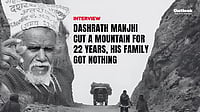- 1202 Number of Everest summiters
- 64 Number of those who are Indian
- 89 Largest number of people who summited on a singleday
- 175 Total deaths on Everest
- 120 Estimated bodies on the peak
- 16 Age of the youngest summiter
- 65 Age of the oldest summiter
- 100 Tonnes of junk on the slope
- $65,000 Amount needed for a person to climb Everest
It's a busy time on the roof of the world. Fifty years after Sir Edmund Hillary and Tenzing Norgay reached the summit of Everest for the first time, something like 49 different expeditions are attempting to repeat the feat and celebrate half-a-century of extreme endeavour.
All kinds of people from every continent have converged: from dedicated professionals to those with almost no climbing experience at all. Jockeying for elbow room are near-novices who want to reach the summit for personal satisfaction to those who want to save the world. As a symbol, Everest is whatever you want it to be.
Someone like Peter Habeler, the celebrated Austrian climber who reached the summit in 1978 without bottled oxygen together with Reinhold Messner, has already bemoaned that this year's Everest expeditions had "nothing to do with real adventure".
Says Habeler: "It's peanuts, climbing surrounded by Sherpas and using oxygen. You cheat the mountain. People are now racing to be the fattest, the thinnest, the youngest, the oldest up Everest."
Commercialisation has acquired absurd proportions. Take for example the US cable channel Outdoor Life Network (OLN). It has been running an adventure game show that will soon, producers hope, climax on the summit. Fifty men and women, young and old, but all of them outstandingly fit, have been slugging it out through jungles and across deserts around the world for a chance to climb Everest and share in the $2,50,000 prize money.
Sponsored by Toyota, dressed in the latest equipment and supported by the best Sherpas money can hire, at least some of the lucky finalists will reach the top, even though only a few among them have mountaineering experience, that too limited.
But while oln's chosen few have encountered everything nature can throw at them, their biggest threat may be the weight of numbers attempting to go to the summit on the same day. If you want the pristine experience Tenzing and Hillary enjoyed, then go somewhere else, as many of the world's best mountaineers have done. The public may be obsessed with the biggest, but for today's top climbers, size isn't everything.
Everest, however, has always been about more than a mountaineering challenge. Nehru understood that perfectly when he rewarded Tenzing for his efforts. He made the Tibetan-born Tenzing the focus of Darjeeling's Himalayan Mountaineering Institute. If Britain could put men on Everest, then why not a newly liberated India? In building a nation, overcoming Everest was a potent message.
Nehru told Tenzing: "Now you will train a thousand Tenzings." Worshipped as a god, hailed as a symbol of the resurgence of Asia, Tenzing was seen by the political elite as an emblem of Indian prestige. Krishna Menon took a personal interest in managing Tenzing's career. Ultimately, the Sherpa would leave the school he helped establish, bitter at the way his masters had treated him.
These days there are more contemporary concerns than nationalism. Everest reflects those concerns, with a recent procession of environmental expeditions tidying up the mountain. And this autumn a team, 'Everest Peace Project', will call for world peace from the summit.
Expedition organiser Lance Trumbull, a Buddhist karate expert and former second-hand book-seller, says climbers from each of the major world faiths, along with an atheist, will climb as an expression of mutual understanding. "It is our goal to show that people from all races and beliefs can come together in a peaceful way and set an example to the world," he said.
But the pressures of climbing the highest altitude has, in recent years, produced the opposite effect. There have been fights over the best campsites, threats of vandalism and, most terrifying to a climber, thefts of equipment by those lacking essential supplies.The team-work that characterises mountain climbing comes under serious threat when personal ambition overtakes everything else.
The last 50 years have seen all kinds of changes on Everest, and the very best and worst of human behaviour. Almost 1,200 men and women have reached the summit, and the total number of ascents is close to 1,600. (The difference is made up by Sherpas and western guides who've been to the top a number of times.)
The current record-holder for most ascents is Appa Sherpa, a slight but monstrously fit 44-year-old, who has reached the summit no less than 12 times. He had contemplated retirement but cannot resist going back for one more try this spring. "But my western friends tell me I will have to go back," he says. "They say it's unlikely for me to stop at 13." The youngest climber to succeed is Temba Tshiri, who was 16 years and 17 days when he reached the summit on May 23, 2001. It's a record that's unlikely to be broken, at least in the short term, since the Nepalese government changed the rules to stop children under 16 being hurried on to the mountain.
Temba himself suffered terrible frostbite after coming close to the summit when he was barely 15 the year before. Following his narrow escape from the mountain he had five fingers amputated. But the handicap didn't stop him going back. Temba's whole family have worked on the mountain, men and women, and they all recognise how their lives could be transformed by setting the kind of records that make western climbers famous.
Temba isn't the only disabled climber to attempt Everest. I'll never forget meeting Tom Whitaker, an expatriate Welshman who lost his lower right leg in a car accident in Idaho in 1979, ending a promising climbing career. We were at base camp on the north side of Everest, Tibet. Inside the warm mess tent, over tea and biscuits, he unstrapped his prosthesis to illustrate how he would be keeping his stump warm high on the mountain. Anticipating a great deal of wear and tear, he had brought three extras.
Several years later I met Erik Weihenmayer who in 2002 became the first blind man to reach the summit. Some climbers find this kind of achievement artificial, given the level of support that's required to get someone up the mountain, but there's no doubting Weihenmayer's courage. But how does someone, who can't see, tackle the huge dangers and challenges Everest imposes?
"I follow somebody who climbs in front with a bell. They jingle it from their ice axe or from their ski pole," says Weihenmayer. "And I'll listen to them while they call out directions. They'll say, 'big drop off' or 'steep climb'. Sometimes you're crossing these very narrow snow bridges. So, they tell you exactly where to step. It's a huge team process. And that's why it was so amazing getting to the summit and hugging everyone and just total celebration, because we'd done it all together."
Technology has played a pivotal role in the last 50 years and allowed many weaker climbers the chance of success. On 29 May, 1953, when Tenzing and Hillary became the first men to reach the summit, they had several innovative pieces of equipment to help them.
Their boots were comparatively light and very warm, with a felt liner. No one on the expedition got frostbite, a rarity in those days. They also had light windproof outer layers to protect them from the freezing winds. But most of their gear was much heavier than that available today.
The day before he went to the summit, Hillary was shouldering a 60 lb load on the mountain's Southeast Ridge, within striking distance of the summit. These days, because of improved equipment, that high a camp isn't even necessary.
Tents are warmer and lighter, so are the sleeping bags; and the thick down suits climbers wear protect them even in the worst weather.Some astonishing survival stories in recent years can all be ascribed to the superb insulating quality of modern climbing gear.
Take the example of Beck Weathers. The Dallas pathologist had been forced to give up his attempt on the summit after developing an eyesight problem. His guide, New Zealander Rob Hall, told him to wait for his return before descending. But Hall became stranded close to the summit with a client whom he refused to leave.
When Weathers finally began descending he was already in a weakened condition. Bad weather concealed the location of the tents pitched at the South Col, the last camp before the summit. Trapped in freezing winds, cold and disoriented, Weathers huddled with a small group of fellow climbers as night closed in.
When rescue finally came, a doctor who examined Weathers decided he was beyond help. He was already in a hypothermic coma, a condition no one escapes. Concentrating on those with a chance of survival, mountain guides worked heroically to get the others to shelter.
But Weathers wasn't finished yet. When the gales eased and the sun came up next morning, something deep within him stirred into life and he regained consciousness. Even though he had lost his gloves—freezing his arms solid—and his face was frozen black, he managed to stagger into the camp. Climbers there thought they were looking at a dead-man-walking.
Maybe, 50 years on from Tenzing and Hillary's great achievement, that's the enduring lesson of Everest. That behind all the petty rivalries and egotism that seem to dominate on Everest today, there truly is something indomitable about the human spirit.






















